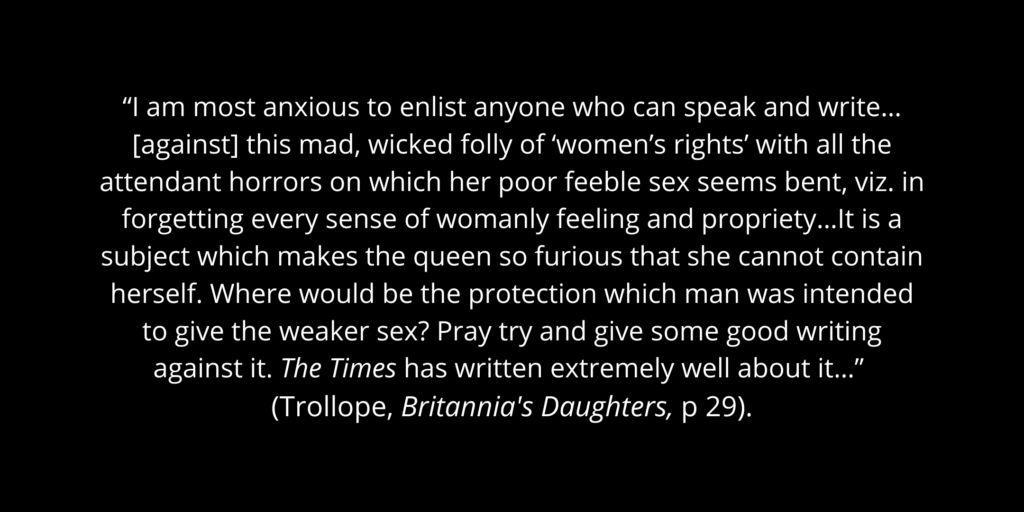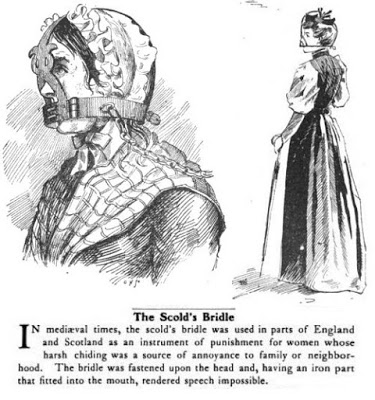
Women Shutting Other Women Down
WHAT’S THE ISSUE: Historically, men have shut down women’s voices. I’ve worked with two teachers (one is a Primary School teacher, the other a Secondary School teacher) who witnessed a husband telling his wife to “shut up” (in front of his child) at Parents Evening. I have yet to hear of a wife, at Parents Evening, telling her husband to “shut up”. It sounds like it’s more common for men to shut women’s voices down, than vice versa. This could lead us to conclude that men are the problem.
There are, however, women in positions of influence who abuse their power and who fight to shut women’s voices down, too.
However, in this article, I’d like to share two historical examples of how women’s voices have been shut down, to emphasize the following point: men are NOT the problem. Controlling behavior is the problem, irrespective of whether it comes from a man or a woman.
SHUTTING WOMEN DOWN: WOMEN OPPRESSING WOMEN

There are women, today, who are responsible for shutting girls’ and women’s voices down, both in family life, and in work life. But this is quite a sensitive issue. So for the purposes of this article, I will focus on a historical example of one of the most powerful women in European history: Queen Victoria.
One of my Year 8 students asked me the following question in the middle of a lesson a few months ago (we were studying the issue of women’s suffrage, and why it took so long for women in Britain to get the right to vote):
“But Miss, Queen Victoria was a woman. So why didn’t she do something?”
What a great question! I didn’t know the answer. I’d never thought about it before.
But while I was reading Joanna Trollope’s fascinating book, Britannia’s Daughters: Women of the British Empire during my summer break, I stumbled on a clue.
This is an extract from a letter written by Queen Victoria in 1870, addressed to a Sir Theodore Martin. Here’s what was going through Queen Victoria’s mind, at the time:

Queen Victoria was, of course, powerful enough to rule without needing “the protection” of a man. Arguably, Queen Victoria was the most powerful monarch Britain in British History…despite being a member of the so-called “weaker sex”.
Now, some may dismiss such behavior as “She’s acting more like a man than a woman”. But I think it’s damaging to society to assume that this toxic form of masculinity is what makes someone “a man”.
Clearly, Queen Victoria’s controlling behavior towards other women had nothing to do with whether she herself was a man or a woman.
This isn’t a gender issue of ‘men versus women’; it’s a behavioral issue.
And let’s stop making dismissive, disempowering statements like: “History always repeats itself” and “We are all simply a product of our time”
Let’s stop talking about the past, present and future in a defeatist way.
I believe we need to understand the politics of emotion, both past and present, if we are to stop this historical pattern of women in positions of power shutting other girls and women down.
Let’s learn from the past.
Let’s stop this pattern of women shutting other women’s voices down.
Let’s call out the bad behavior, whenever we see a woman shutting other women down.
Let’s break the pattern.
SHUTTING WOMEN DOWN: MEN OPPRESSING WOMEN

Nagging is a way of expressing anger (in its milder form). When someone nags you, they’re feeling annoyed or irritated or irritated about something.
For such a minor offence as expressing a mild form of anger through nagging, the law in Victorian Britain gave husbands the freedom to lock their wives into one of these humiliating torture devices, which came to be known as the “scold’s bridle”.
These devices were also used to shame women who were deemed to be too assertive, loud or talkative into silence in other European countries, like Germany, France, and Belgium.
These cruel practices, dating back to the Middle Ages, were certainly being challenged by many in Victorian Britain. However, there were still 33 scold’s brides in circulation in Britain in 1900.
Some husbands who would use these devices bought would even choose ones that had spikes on the metal rod that went into the tongue; these spikes were designed to lacerate the tongue of their victim, whenever they tried to talk. These men were sending a clear message to their wife: “Shut up! I don’t care about your opinion and your emotions. I’m tired of hearing your voice.”
Clearly, husbands who forced this device onto their wife felt entitled. This behavior illustrates how this type of men believed they should control when women speak, and what they talk about (heaven forbid a wife DARE to express feeling irritable or angry; “good girls” don’t get angry!)
When you go back to the Middle Ages, you discover that there were even women who’s husbands forced them to wear a scold’s bridle with a bell on top as an additional form of humiliation, while he paraded his wife to be mocked by other villagers in the village square.
The scold’s bridle is a reminder of the fact that, for centuries, Western societies have forced women to turn their anger inwards, rather than risk experiencing the pain, shame and humiliation that came with being punished for being judged to be ‘too loud’, too assertive, and not ‘silent’ enough for abusive men.
According to an article published by the NHS (2017): women in Britain continue to be more at-risk than men for suffering from abusive spouses.
While the scold’s bridle is certainly a thing of the past, the issue of domestic violence that the scold’s bride represents continues to plague many women’s lives in the so-called ‘developed world’, in the 21st century.
MY HOPE FOR THE FUTURE
Historically, bullies have used anger and shame as tactics to silence victims’ voices.
Up until now, these tactics have been successfully used by many a family member, community leader, school leader, company, and government, to control and manipulate girls and women into submission.
They were effective in silencing victims of abuse, oppression and exploitation, and by so doing, they were effective in maintaining the status quo.
Before the Information and Technological Revolutions democratized publication, we had a highly centralized, top-down approach to publishing news, and to sharing experiences and information.
But the tide is turning, thanks to these two revolutions.
More and more girls and women can now challenge the status quo by sharing their stories.
You see more and more girls and women who speak up, motivated by a desire for a kinder, safer, more humane world, both for themselves and for other girls and women who may be going through what they went through.
Because we all have the right to feel safe at work, and in the home.
Look at Alysia Montano. Alysia is courageously calling out a well-known brand that’s failing to treat the women they sponsor with the respect to women’s rights that they claim to value in their advertising campaigns and their company’s branding.
Look at Mary Cain. Mary Cain found the strength to share her story of psychological abuse and professional neglect in a revealing video that’s gone viral: “I Was The Fastest Girl In America, Until I Joined Nike”.
So what’s my hope for 2020 [and beyond], with regards to girls’ and women’s well-being?
I hope to see more and more girls and women speaking up.
I hope to see more and more girls and women standing up for themselves.
I hope to see more and more girls and women use their voice as a positive force for pro-social change.
Remember: We are living in a time in History when more girls and women are educated than ever before!
Ladies, let’s use our education to shine a light on injustice, exploitation, and abuse of power.
Let’s use our voices to stand up for ourselves in the face of injustice.
Let’s share our stories.
It’s time to stop holding on to secrets.
It’s time to speak up, rather than suffer in silence.
It’s time to start holding people who abuse their power accountable.
Time is up.
ABOUT THE AUTHOR
https://elenivardaki.com/eft-practitioner/




